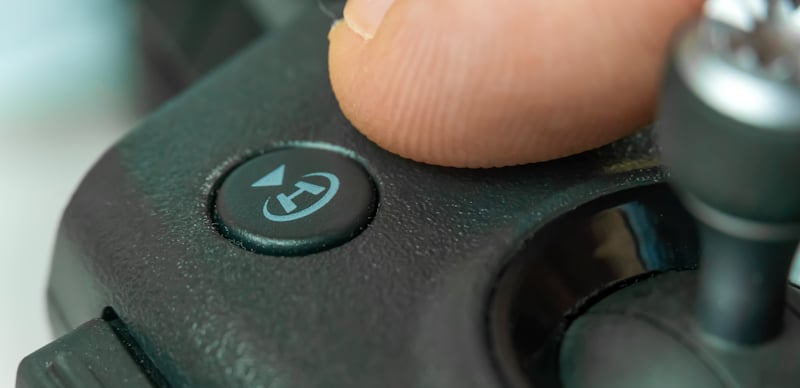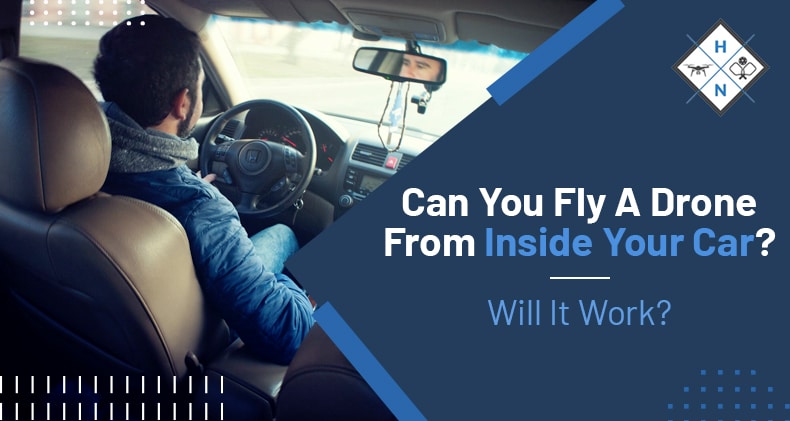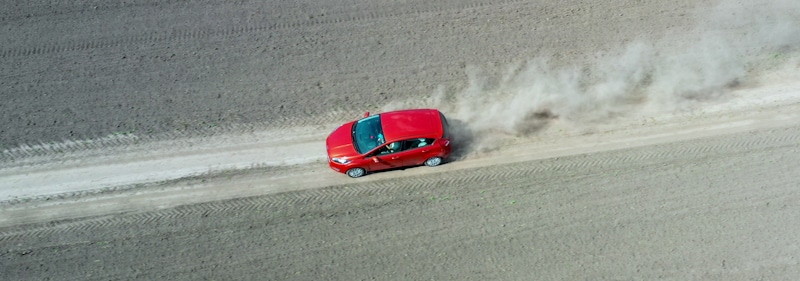Flying a drone is something that you probably enjoy doing so much that you want to do it as frequently as possible. You may even want to try flying your drone in a variety of situations which may leave you wondering if you can fly your drone from inside your car.
You may argue that you can fly a drone from inside of your car as long as you maintain the drone in your line of sight. However, according to Section 336 Part 107 of Public Law 112-95 this is wrong. In fact, it is deemed illegal to fly a drone from inside your vehicle even when it isn't moving.
Why Fly a Drone From a Moving Vehicle
You may find yourself wondering why anyone would want to fly a drone from inside of their car in the first place. However, if you stop to think about all the things drones can be used for (e.g. mapping, surveying, inspecting), you'll see how useful this could be. Drones are used in architecture, construction, agriculture, and science today because they're relatively fast in collecting large amounts of spatial-related data that can be used to create 3D, topography, photogrammetry, and crop density maps. The main challenge here is covering such large areas.
Although most drones have a range of four miles, the law clearly states that the pilot or visual-observer must be able to see the drone at all times. This severely limits how much area a drone can cover from a single vantage point. Depending on the terrain they may only be able to cover a 2-mile distance at most. If you can operate your drone from a moving vehicle you can see even further and thus be able to survey an even larger area. Unfortunately, according to Section 336 Part 107 of Public Law 112-95 this is illegal though.
Understanding Section 336 Part 107 of Public Law 112-95
In August 2016 this law was enacted especially for drones that are being operated for commercial purposes. According to Part 107 of this law ("No person may operate a small unmanned aircraft system from a moving land or water-borne vehicle unless the small unmanned aircraft is flown over a sparsely populated area and is not transporting another person's property for compensation or hire"), commercial drone pilots must get a remote pilot certificate and comply with all restrictions set forth by the FAA. In specific, Part 107 restricts pilots from operating a drone from inside of a moving vehicle.
As commercial drone use becomes more popular this restriction has become more challenging. Many commercial drone pilots are trying to determine if there's a way they can legally fly their drone while inside a moving vehicle.
The Challenges of Flying a Drone From a Moving Vehicle
Many speculate that one of the reasons why the FAA has enacted this law is because of the various challenges that a pilot may face when trying to operate their drone from a moving vehicle. Flying your drone in this way is difficult and there are many things you must be on the lookout for.
Keeping up with Your Drone
To maintain visual contact and radio communication with your drone it needs to move at about the same speed as your vehicle. This is challenging because there are hazards that can slow you or your drone down. Additionally, you'll need to maintain great communication between the drone pilot and the vehicle's driver who must also not be distracted while driving the vehicle.
A Dynamic Environment
Over the course of a long drive, your drone will face a variety of hazards, terrain, obstacles, and air traffic. It'll need to fly at different altitudes to avoid these obstacles. If you don't plan carefully, you may even run into densely populated areas that it's illegal for your drone to fly over.
FAA Waivers
If you're a commercial drone pilot, then there's a potential waiver you can obtain from the FAA regarding some of the Part 107 restrictions. While the restriction regarding flying your drone from a moving vehicle is included within these provisions, there haven't been many waivers granted for this since the Part 107 regulations were enacted in August 2016. This is disheartening when you consider that over 2,000 waivers have been requested. It means that the FAA has granted under 0.2% of these waivers while the others have more than likely been rejected.
This information probably makes you wonder what it takes for the FAA to grant this waiver. If you take a closer look at the waivers that were granted you'll see that two were awarded to FLIR Unmanned Aerial Systems for the use of the Prox Dynamics PD-100 drone, which is a military-grade nano-drone that weighs slightly more than half an ounce. These drones also have night vision capabilities and can transmit live video streams and high-resolution images up to 1-mile. It's also important to note that according to the waiver that was granted, the vehicle's driver couldn't be involved in any form of drone operation.
One of the other waivers was granted to a company called TPS at Fort Mac. The waiver specifies that the drone was only to be used for closed-set motion picture and television filming. It also specified that there must be three drone operators each of whom would have a distinct role (the remote PIC, the visual observer, and the person operating the drone). Additionally, the waiver also stated that these three people must use hands-free devices when communicating with each other.
Unfortunately, none of these waivers provided details regarding how much distance the drone could cover. However, each of them was very specific in stating that the drone must only fly within a specific geo-fence. If it were to inadvertently leave these areas the drone must be programmed with a safe flight termination sequence.
Clearly, the FAA is very selective when it comes to granting these waivers. This doesn't mean that you shouldn't request this waiver but you probably shouldn't rely on it being approved. Your time is better spent trying to work around this law. For instance, you can fly your drone from a moving vehicle in a sparsely populated area so you do have some "wiggle" room here. If you do decide to apply for a waiver, make sure you give the FAA 90 days to get back to you.
Tips for Flying From a Moving Vehicle
If you're not lucky enough to get a waiver that allows you to fly your drone from a moving vehicle, it's going to take you a lot of time and effort to be able to do so. You will need to have a highly skilled team, a well-defined area that you'll be surveying, and a drone that's equipped with the right technology. With this in mind, here are some recommendations you should follow if you do decide to engage in this activity.
Have a 3-Person Team
Even if you have a waiver the FAA still recommends that you have a 3-person team that includes the person who's dedicated to driving the vehicle, the drone's pilot, and a visual observer. This is good advice since it helps to ensure that nobody's attention is spread too thin. You may even want to add a fourth person so you have one person to observe the drone and one to observe your surroundings. Regardless of how many people you have, communication is vital so you should have a pre-flight meeting to establish a plan of action then make sure you communicate throughout the entire time.
Plan Your Route
Before you actually start flying your drone you should take some time to drive your planned route. Pay attention to changes in the topography as you do so. This is also your opportunity to make sure that the area in which you plan on flying is indeed sparsely populated. Remember that if it isn't, you shouldn't fly your drone here.
Know how to Fly Your Drone Manually
While most drones come with an autopilot feature that allows you to set a planned route, when you're flying your drone over a long distance this may not be something that's advisable to use. Remember, as your drone travels over the course of several miles it's going to meet a variety of conditions. This isn't something that your drone's autopilot feature is designed to make adjustments for.
You also need to remember that even though your drone is able to travel in a straight line your car will need to make twists and turns as it follows the road. For this reason, you may need to either speed up or slow down your drone so that it can keep pace with your vehicle. This is why a rookie pilot shouldn't try to fly their drone from a moving vehicle even in the best of conditions. Instead, leave this type of flying to the more experienced drone pilots.
If your drone should happen to lose signal with your remote controller make sure you instruct the drone to automatically hover in place. This will be your safest option because it'll let you move towards the drone which will reestablish its signal.
Watch Your Drone's Battery Levels
You need to watch your drone's battery levels as you're flying. Since your drone and its controller will be continuously moving your battery will drain faster than usual. You need to make sure that your drone will have enough power to be able to return to you. Never rely on the measured distance between you and your drone. If the GPS makes a mistake it can mean the difference between landing safely and crashing.
If you do get to a point where you've reached your drone's critical battery level make sure your home position is set to dynamic. This will ensure that your home position is continually being updated to the place where your remote controller is located. Even if your drone does lose the remote controller signal it'll still fly to your last recorded location which shouldn't be too far away.

Disable the Return-to-Home (RTH) Feature
Your drone's RTH feature is activated in one of two circumstances. First, it can be activated when your battery reaches the critical level, and secondly, it can be activated anytime your drone and remote control lose signal with one another. This is why before you take flight with your drone you should take a moment to make sure you turn off its return-to-home feature. Failure to do so could result in a major issue since you're no longer at your original take-off point.
Avoid Obstacles
There have been a lot of great improvements made in the obstacle avoidance technology of today's drones. This technology is very useful when you're trying to fly your drone from a moving vehicle since it'll allow your drone to automatically avoid any obstacles it may encounter so your drone won't become damaged. However, it's important to understand that this doesn't mean that your drone can be fully autonomous once you've set its flight path. You're still the one who's ultimately in control when it comes to maneuvering your drone.
Conclusion
Clearly, the FAA is currently being very restrictive in regards to granting people a waiver to fly their drone from a moving vehicle. However, there is some indication that the FAA may consider loosening this restriction in the future as new technology makes this activity safer to engage in. Currently, they seem set on only allowing small, military-grade nano-drones that don't weigh very much to fly over populated areas. Most of these drones are also equipped with expensive technology but hopefully, this will become more affordable in the future. So, while it may sound like a lot of fun to be able to fly your drone from inside a moving car, this is illegal, unfortunately. Some may argue that as long as the drone is within your line of sight it should be legal. However, according to Section 336 Part 107 of Public Law 112-95 this is not the case.
Shawn Manaher loves to play with new toys and dive into new hobbies. As a serial entrepreneur, work definitely comes first but there is always room for hobbies.



